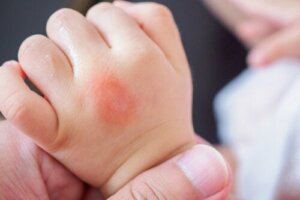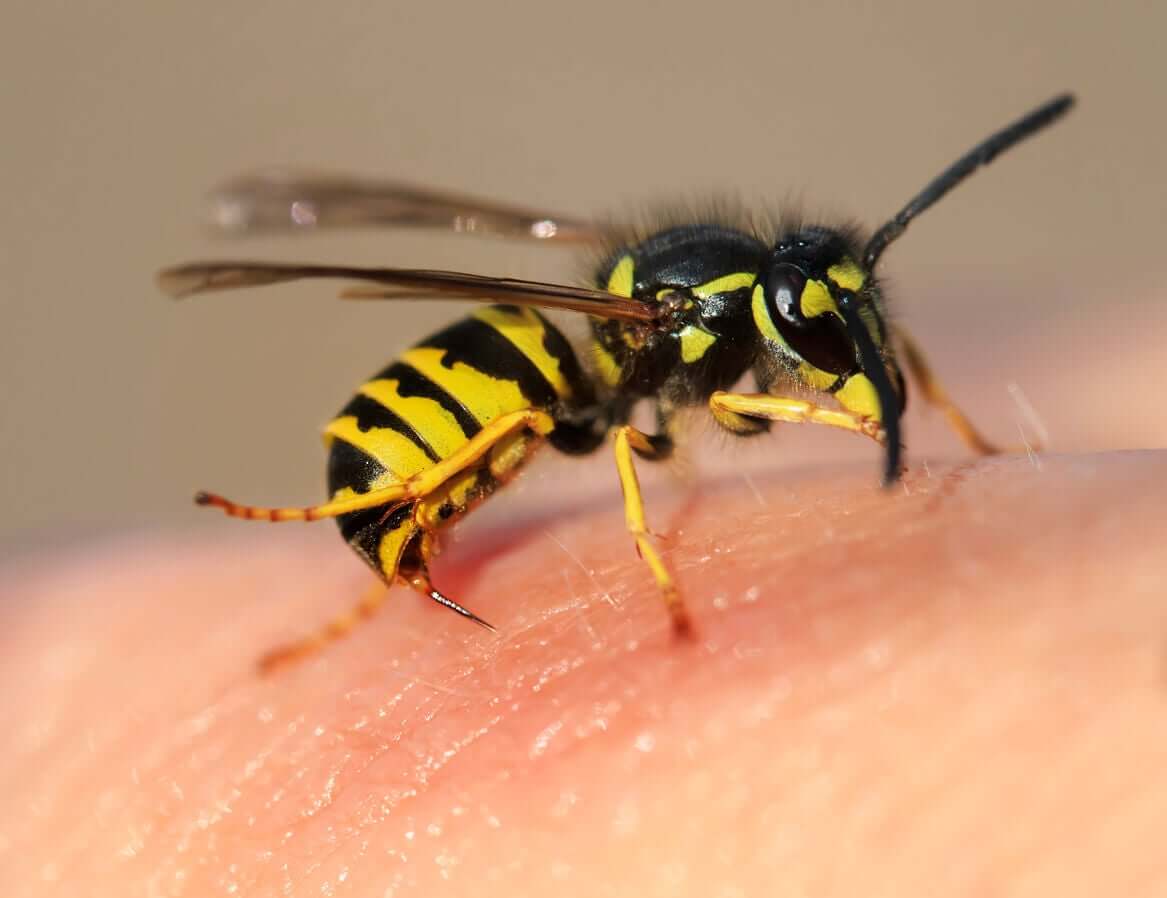How to Identify Insect Bites in Children?


Written and verified by the dermatologist Maria del Carmen Hernandez
Insect bites in children are quite common. In general, these occur during the summer months, as there’s a greater surface area of exposed skin. There are multiple clinical manifestations of stings, from local erythema to severe anaphylactic reactions. In turn, bites can act as vectors for various diseases, so it’s essential that you be able to recognize insect bites in order to deal with their consequences.
In this article, we’ll tell you how to identify the different insect bites in children.
The most common symptoms of insect bites in children
In order to be able to identify insect bites, you need to be aware of their varying symptoms. Most insect bites cause minor discomfort in children. However, some of them can cause more serious and complicated symptoms.
The milder symptoms or signs of bites are as follows:
- Swelling
- Erythema or rash
- Local pain or heat
- Pruritus
Signs and symptoms of a serious reaction, which should be treated immediately, include some of the following:
- Fever
- Difficulty breathing
- Nausea and vomiting
- Fast heartbeat (tachycardia)
- Edema of glottis and lips
- Muscle spasms
Most insect bites in children heal on their own after several days of mild discomfort.

The most frequent insect bites in children
Insects can bite children on any part of their body, but most often, they do so on those areas where the skin’ exposed. In addition, some take much longer to disappear than others, so the discomfort of each one is variable.
For this reason, it’s essential that you know some particular characteristics of the injuries caused by different insects. Take note!
Ant stings
Red ants (or fire ants) are quite aggressive insects because when they bite, they produce very painful reactions. Their venom is even capable of causing intense local inflammation and in some cases, it triggers an anaphylactic reaction.
In general, these bites occur on the lower limbs of children. The immediate reaction to contact with the poison is an intense burning sensation, which disappears after a few minutes.
After a while, an outbreak appears on the skin, with very annoying papules and welts. Eventually, vesicles develop that give rise to sterile pustules.
Mosquito bites
Mosquito bites usually cause minimal trauma and children often don’t feel when they occur. However, the most common symptom is itching and the appearance of urticarial welts on the skin.
These hives are small, round, and swollen bumps, and it’s common to find several grouped in the same area.
Treatment options for mosquito bites are symptomatic and include topical corticosteroids, the application of ice on the site, and the use of systemic antihistamines.
Flea bites
In most cases, flea bites appear as erythematous papules with a hemorrhagic center. In addition, they can cause hives, blisters, or vesicles, as described in a review published in Pediatrics Annals.
Flea bites are usually found in clusters on the lower legs or feet. Itching can be intense and scratching tends to develop skin abrasions, which can lead to a secondary bacterial infection.
Therefore, the primary goal in managing flea bites is to control severe itching with corticosteroids, topical calamine lotions, and systemic antihistamines.
Read also: All About Flea and Spider Bites in Children
Tick bites
Tick bites in children are usually painless and can manifest with a wide variety of rashes. This greatly complicates the differential diagnosis with other types of bites.
Generally, an erythematous papule with surrounding erythema is visible, although it can also cause pruritic urticarial lesions.
On some occasions, it’s possible to observe the tick attached to the child’s skin, which requires gentle and careful removal with tweezers.
When the bites are simple and uncomplicated, only routine care is necessary, such as the use of corticosteroid creams and systemic antihistamines. In case of secondary infection, antibiotics can be added.
Wasp or bee stings
Bee stings can cause temporary sharp pain, warmth, erythema, swelling, and itching in the area of the sting.
An important fact is that when the bee stings, it releases its stinger in the skin and dies. This differentiates it from the sting of wasps, which don’t lose their stingers and can sting more than once before dying.
Mild allergic reactions can cause increased swelling at the site or extreme redness. And according to an article in the Journal of Paediatrics and Child Health, severe allergic reactions include the following manifestations:
- Urticaria
- Intense itching
- Pale skin
- Edema of the glottis and tongue
- Difficulty breathing
- Accelerated pulse
Mild cases are treated with cold compresses to reduce swelling and pain, anti-inflammatories, and corticosteroid or calamine creams.

You may be interested in: All About Flea and Spider Bites in Children
Insect bites in children and their evolution
In general, insect bites in children cause swelling and pain, which provides an entry point for bacteria to develop a secondary infection.
The most important allergic response to insect stings is the development of anaphylaxis, which can be fatal and must be treated urgently with epinephrine. For this reason, it’s important to know the child’s allergy history to different bugs and insects.
Insect bites in children are quite common. In general, these occur during the summer months, as there’s a greater surface area of exposed skin. There are multiple clinical manifestations of stings, from local erythema to severe anaphylactic reactions. In turn, bites can act as vectors for various diseases, so it’s essential that you be able to recognize insect bites in order to deal with their consequences.
In this article, we’ll tell you how to identify the different insect bites in children.
The most common symptoms of insect bites in children
In order to be able to identify insect bites, you need to be aware of their varying symptoms. Most insect bites cause minor discomfort in children. However, some of them can cause more serious and complicated symptoms.
The milder symptoms or signs of bites are as follows:
- Swelling
- Erythema or rash
- Local pain or heat
- Pruritus
Signs and symptoms of a serious reaction, which should be treated immediately, include some of the following:
- Fever
- Difficulty breathing
- Nausea and vomiting
- Fast heartbeat (tachycardia)
- Edema of glottis and lips
- Muscle spasms
Most insect bites in children heal on their own after several days of mild discomfort.

The most frequent insect bites in children
Insects can bite children on any part of their body, but most often, they do so on those areas where the skin’ exposed. In addition, some take much longer to disappear than others, so the discomfort of each one is variable.
For this reason, it’s essential that you know some particular characteristics of the injuries caused by different insects. Take note!
Ant stings
Red ants (or fire ants) are quite aggressive insects because when they bite, they produce very painful reactions. Their venom is even capable of causing intense local inflammation and in some cases, it triggers an anaphylactic reaction.
In general, these bites occur on the lower limbs of children. The immediate reaction to contact with the poison is an intense burning sensation, which disappears after a few minutes.
After a while, an outbreak appears on the skin, with very annoying papules and welts. Eventually, vesicles develop that give rise to sterile pustules.
Mosquito bites
Mosquito bites usually cause minimal trauma and children often don’t feel when they occur. However, the most common symptom is itching and the appearance of urticarial welts on the skin.
These hives are small, round, and swollen bumps, and it’s common to find several grouped in the same area.
Treatment options for mosquito bites are symptomatic and include topical corticosteroids, the application of ice on the site, and the use of systemic antihistamines.
Flea bites
In most cases, flea bites appear as erythematous papules with a hemorrhagic center. In addition, they can cause hives, blisters, or vesicles, as described in a review published in Pediatrics Annals.
Flea bites are usually found in clusters on the lower legs or feet. Itching can be intense and scratching tends to develop skin abrasions, which can lead to a secondary bacterial infection.
Therefore, the primary goal in managing flea bites is to control severe itching with corticosteroids, topical calamine lotions, and systemic antihistamines.
Read also: All About Flea and Spider Bites in Children
Tick bites
Tick bites in children are usually painless and can manifest with a wide variety of rashes. This greatly complicates the differential diagnosis with other types of bites.
Generally, an erythematous papule with surrounding erythema is visible, although it can also cause pruritic urticarial lesions.
On some occasions, it’s possible to observe the tick attached to the child’s skin, which requires gentle and careful removal with tweezers.
When the bites are simple and uncomplicated, only routine care is necessary, such as the use of corticosteroid creams and systemic antihistamines. In case of secondary infection, antibiotics can be added.
Wasp or bee stings
Bee stings can cause temporary sharp pain, warmth, erythema, swelling, and itching in the area of the sting.
An important fact is that when the bee stings, it releases its stinger in the skin and dies. This differentiates it from the sting of wasps, which don’t lose their stingers and can sting more than once before dying.
Mild allergic reactions can cause increased swelling at the site or extreme redness. And according to an article in the Journal of Paediatrics and Child Health, severe allergic reactions include the following manifestations:
- Urticaria
- Intense itching
- Pale skin
- Edema of the glottis and tongue
- Difficulty breathing
- Accelerated pulse
Mild cases are treated with cold compresses to reduce swelling and pain, anti-inflammatories, and corticosteroid or calamine creams.

You may be interested in: All About Flea and Spider Bites in Children
Insect bites in children and their evolution
In general, insect bites in children cause swelling and pain, which provides an entry point for bacteria to develop a secondary infection.
The most important allergic response to insect stings is the development of anaphylaxis, which can be fatal and must be treated urgently with epinephrine. For this reason, it’s important to know the child’s allergy history to different bugs and insects.
All cited sources were thoroughly reviewed by our team to ensure their quality, reliability, currency, and validity. The bibliography of this article was considered reliable and of academic or scientific accuracy.
- Kamath S, Kenner-Bell B. Infestations, Bites, and Insect Repellents. Pediatr Ann. 2020 Mar 1;49(3):e124-e131. doi: 10.3928/19382359-20200214-01. PMID: 32155278.
- Quercia O, Incorvaia C, Marseglia GL, Puccinelli P, Dell’albani I, Emiliani F, Frati F, Stefanini GF. Prevalence and incidence of reactions to insect stings in children: a reappraisal. Minerva Pediatr. 2014 Aug;66(4):257-60. PMID: 25198560.
- Tan JW, Campbell DE. Insect allergy in children. J Paediatr Child Health. 2013 Sep;49(9):E381-7. doi: 10.1111/jpc.12178. Epub 2013 Apr 16. PMID: 23586469.
- Kruse B, Anderson J, Simon LV. Fire Ant Bites. 2021 Aug 11. In: StatPearls [Internet]. Treasure Island (FL): StatPearls Publishing; 2021 Jan–. PMID: 29261949.
This text is provided for informational purposes only and does not replace consultation with a professional. If in doubt, consult your specialist.








